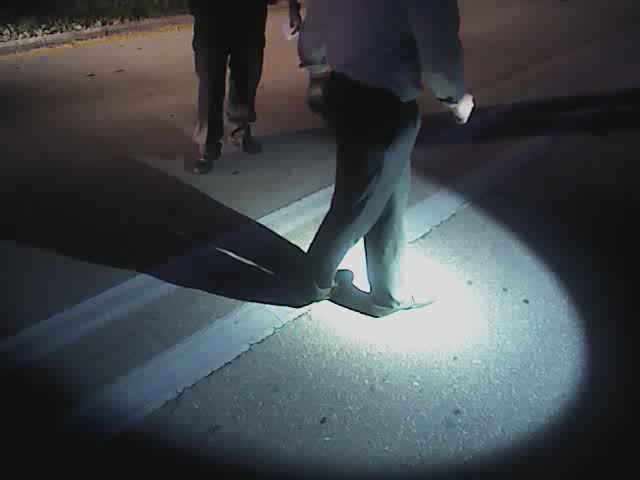As more agencies implement body-worn cameras (BWCs), it’s only natural for law enforcement personnel to utilize them to gather evidence in impaired driving cases. The use of the BWCs in impairment investigations considerably augments evidence gathering capabilities. However, there are certainly some limitations to all BWC systems that users, supervisors, and command staff should be aware. BWCS are not the panacea that some hoped they would be, but they are an effective tool when used with proper training. DUI enforcement is NOT a Hollywood production—the primary goal is gathering evidence. Officers must follow the agency policy and state laws governing the use of BWCs and when it is mandatory to start and stop a recording. So how can BWCs be used most effectively in impaired driving investigations?
Camera Versus the Human Eye
A BWC is just an imperfect imitation of the human eye, with emphasis on imperfect. There are functions of the human eye that cameras cannot accurately replicate, and some functions that cameras can perform better than the human eye. Some of these major differences are in depth perception, detail, and color, among others.
Depth perception—Human eyes are designed to see depth even to the slightest degree, which is caused by having two eyes. The eye acts similar to a camera lens and transmits an image to the brain, where the image is actually seen. A camera has only a single lens, and the information is transmitted to a flat screen, causing a loss of depth, which results in video being seen in only two dimensions.
Detail—Digital technology has advanced significantly through the years and can allow cameras to see fine details often missed by the human eye.
Peripheral vision—This is the ability of the eye to see to the sides while still viewing forward. Ambient vision, also known as the parafovea, is the area around the fovea that decreases in clarity as the visual angle increases away from the focal point. Human peripheral vision is designed to detect motion, but without details and clarity; whereas, a camera will capture all areas of the recording with the same acuity.
Colors—The human eye has two types of cells that capture light: cones and rods. The cones pick up colors and are mainly concentrated in the fovea. The parafovea has a small number of cones, mostly rods, and therefore, it is difficult for humans to differentiate colors when seen from the corner of the eye (not an issue for cameras).
Instant Replays—Once a camera has recorded an event, the event can be viewed again exactly as it was captured; whereas, a human brain adds and subtracts details based on perception, focal point, stress, and other stimuli. During high stress, a phenomenon known as sensory gating causes the brain to ignore certain sensory information that it deems as insignificant. A camera is not susceptible to this phenomenon and will objectively record what is presented in front of the lens, which is immeasurably more information than is humanly possible to remember.
BWC technology is always evolving, but, currently, there is no camera that can record an event exactly as it was perceived by the officer who experienced it. The video recorded by the camera is a 2D representation of what people see in a 3D world and, therefore, some small details like depth, distance, bracing, tensing, and so forth will be missed. In the same vein, just because the video picked up certain actions or indicators does not necessarily mean the officer was able to see the same thing. The focal vision (fovea) is the only portion of the eye through which humans see with 100 percent visual clarity. The fovea can see only one to three degrees of visual angle at a time, compared with most BWCs’ capabilities to capture around 140 degree angles of view. Cameras and their resulting videos cannot identify the region where the officer was looking or exactly what the officer was focused on at any given time.
Camera Positioning
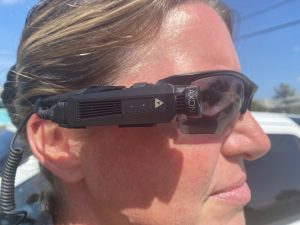
Depending on the BWC system, the user may have limited mounting options. For those systems that do have multiple mounting options available, the one that allows a point of view (POV) option is the best for collecting video evidence during impaired driving investigations. The POV mount is positioned on the user’s head to allow the camera to turn in the direction of the officer’s head and thereby more accurately capturing evidence of where the officer is looking.
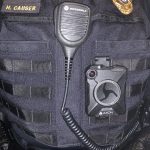
This is considerably important during the standardized field sobriety tests (SFSTs). Conversely, a camera mounted on the officer’s torso turns only when the entire body turns.
In addition, an officer that has more midsection girth can actually have the BWC pointing on a slightly upward angle.
This can cause the suspect’s feet to not be recorded during the SFSTs due to their being outside the BWC’s angle of view.
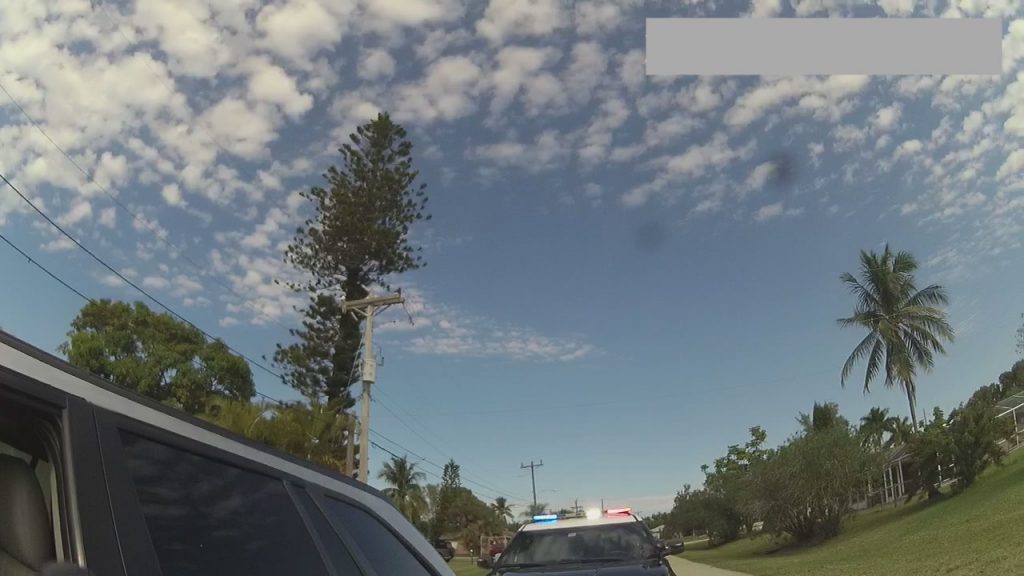
The BWC wearer should never sacrifice safety for the ability to capture video evidence during any incident, to include impaired driving enforcement. Officer safety should always be the officer’s first consideration. Once an officer initiates contact with a member of the public, the officer’s full attention should be focused on the person and any issues in relation to the BWC system should be addressed only when it is safe to do so.
How much of the scene a BWC captures within its field of view is highly dependent on where it’s positioned and where the investigation takes place. Depending on location and angle, the suspect may be blocked from the camera’s view by the officer. Taking notes during the investigation to later assist in report writing is a common practice, but it is important that the officer does not obstruct the camera view with the handheld notes. The officer may even be unaware that his or her hand, writing instrument, or arms are obstructing the camera lens. Another consideration from a practitioner’s perspective is the enhanced benefit of having multiple videos with an additional officer on scene or an in-car camera. Videos from multiple angles will lessen the challenges of utilizing a single camera perspective.
Lighting and Audio Considerations
Some BWC systems are designed to mimic the human eye as closely as possible. Therefore, some recordings in low-light environments may lack color and detail. While some BWC systems have low-light capabilities, this is not always advantageous to the officer because the images they record are not what the officer sees. Depending on the BWC angle, high-intensity lights can cause a shadow effect or “washout” on video and the evidence then cannot be seen on the video. These limitations are further examples of the differences between cameras and the human eye previously discussed. Certain background noise can distort the audio recorded by the BWC. The user can offset some of this risk by turning off the in-car stereo, moving away from loud noises (firetrucks, construction, etc.), and making sure the radio microphone is not directly next to the BWC.
Environmental Factors
With changing climate conditions, a video system may experience some minor issues. Most, if not all, can be corrected by the operator of the system. In high-humidity conditions, the camera lens will have a tendency to accumulate at least some condensation when moving from a climate-controlled area into the humidity. The condensation can be removed from the lens by a manufacturer-specified method; officer safety permitting. A microfiber cloth is usually best and will not damage the glass lens of the BWC. Excessive hot and cold temperatures that the human body can survive in will not normally affect the functionality of the BWCs currently on the market. However, the battery and battery life can be affected by extreme temperatures.
Evidentiary Use
Evidence in impaired driving cases perishes rapidly, so documenting it at the time it is occurring can be very beneficial in building a case. The use of the BWC makes it easier to document the incident by providing a chronological commentary. If agency policy allows, the officer should watch the BWC video footage to assist in writing the required report. In the case of an impaired driving arrest report, the officer’s verbalization captured on the BWC will significantly assist in accurate report writing.
Vehicle In Motion
The officer observes an action like a traffic violation or erratic driving and elects to start a recording. If the officer’s BWC has a designated pre-event capture, depending on the settings and the camera position, previous activity on the part of the observed vehicle and driver may be recorded. Nonetheless, before making the traffic stop, the officer should recap by verbalizing what triggered the requirement to start the recording. If there wasn’t an actual violation, the observations may only be an opinion, but it could lead to a reasonable suspicion that the driver is impaired—and that opinion needs to be preserved.
Personal Contact
There are things the suspect may be doing that the video might not capture, such as the suspect tensing when the officer grasps his or her arm. Additionally, there is no way for the BWC to know what the officer is thinking and perceiving, so articulating to the camera a play-by-play commentary paints the picture of what is happening. Narrating observations that the BWC cannot record should be done to document things like odors, presence of sweating, shaking, body tremors, gaze, and any hard to see mannerisms on the part of the suspect. Using a flashlight at night to highlight such things as small objects or liquids on the clothing, such as urine, also bolsters evidence gathering. Verbalizing the indicators of impairment should be done in a manner consistent with professionalism. When the officer verbalizes the odor of an alcoholic beverage coming from the person’s breath, it should be described as strong, moderate, or faint instead of, for instance, “like the person swam in a vat of rum.”
When the officer obtains the documents for the driver and vehicle, the officer should attempt to verbalize the pertinent information and capture them on camera. Officers should consult their agency’s policy for specifics regarding video recording. The BWC can be an effective tool when collecting detailed information, showing attitudes, demonstrating impairment, and other uses that are not necessarily going to be captured in a written statement.
Pre-Arrest Screening
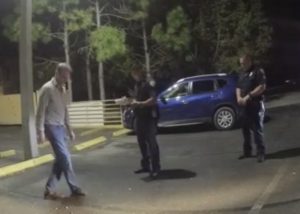
The officer should follow the most current SFST guidelines of the National Highway Traffic Safety Administration (NHTSA), remembering to verbalize the observations and the indicators.
It’s very difficult to see horizontal gaze nystagmus (HGN) on a torso-mounted BWC video, and it’s not recommended that the officer attempt to get close-ups of the eyes while out in the field for officer safety reasons. This is where verbalization is key to document what clues of impairment the officer observed. A stationary vertical object in the background, such as power or light pole, can assist those watching the BWC video in referencing the suspect swaying.
During the walk and turn and one leg stand tests, the officer will want to capture as much of the subject’s body as possible, especially the feet, within the BWCs view. The officer should stand, if possible, at an angle to the line during the walk and turn test so the BWC angle of view can capture the subject missing heel to toe, using arms for balance, and stepping off the line. If the officer doesn’t want the suspect to possibly hear any commentary during the SFSTs, an option is to use nonverbal cues, such as moving one’s hand in a downward motion if the suspect misses heel to toe or using a flashlight’s strobe function.
Chemical Testing
When the suspect is taken into custody, try to conduct the arrest procedure on camera. Capture the Miranda warnings and, if applicable, implied consent warnings on BWC. Continue to record any statements or comments that the suspect makes while in the officer’s care and custody. If the agency policy allows, the BWC should continue recording while obtaining breath, urine, or blood for testing.
Drug Influence Evaluation
A BWC is a new tool in the evidence gathering role of a drug recognition expert (DRE). When a DRE conducts the standardized and systematic 12-step drug influence evaluation, it’s in a controlled environment, in contrast with the initial traffic stop and SFSTs. Because of this, there is usually more flexibility with the use of a BWC and what can be captured. The BWC can be removed from the officer, if agency policy allows, and placed on a nearby counter for a larger field of view or another officer can hold a BWC to obtain evidence not normally in view. Even if there is a surveillance camera in the room where the drug influence evaluation is being conducted, it’s always better to have more angles, which will inevitably capture more evidence.
Recording a thorough interview during the preliminary examination will give further credence to the DRE’s initial contact with the suspect. This is particularly important when there is a significant change in indicators the arresting officer saw at roadside compared to what the DRE is currently seeing when dealing with a drug’s onset and duration effects. It is imperative that when a BWC is used by a DRE during this process that verbalization continues throughout the investigation. There are numerous indicators that a BWC cannot normally capture, and it is incumbent upon the DRE to give commentary regarding those details, such as the suspect’s pulse, blood pressure results, body temperature, muscle tone, etc. During the finger to nose test, the BWC can be moved closer to the suspect so that a clear view of the upper body and nose can be captured on video.
Officer safety should always take precedent over the camera’s view. One part of the DRE evaluation procedures is to conduct a darkroom examination of the eyes in different lighting conditions. Due to the limited light, a BWC will most likely not be able to capture a great deal of video evidence so the verbalization by the DRE is paramount during this step in the process.
If the recording is going to be stopped, verbalize that fact and give the date and time, regardless of which part of the investigation is taking place at that time. If the recording is started again later, this allows the elapsed time to be known and explained, if necessary, for court purposes.
Court Preparation
Officers should review BWC video before any court proceeding to be able to narrate what is occurring in the video and their perceptions of those events. Using the example of a DUI arrest, the officer’s testimony will require that he or she point out the indicators of impairment while the video is played for the jury. A good prosecutor will have already compiled a list of indicators for closing arguments to the jury. However, he or she cannot comment on them in closing arguments unless the officer has actually testified to them or they are clear on the video. If there are 29 indicators, try not to miss any of them.
Video Storage
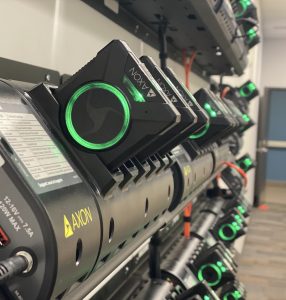
Videos achieve the illusion of movement by projecting multiple images on a screen in quick succession. The images appear to move because of a phenomenon known as persistence of vision. The number of individual pictures recorded each second is called the frame rate. Most BWC systems record at 30 frames per second (fps). When videos are recorded at 24 fps or slower, the motion will no longer appear fluid and will appear to flicker.
Digital cameras record data to digital media such as flash memory cards or a hard drive. The size of the data the video requires is dependent on the resolution, frame rate, and data compression used. Because storage of media is limited, nearly all digital video we see today is compressed in order to improve the efficiency of both storage and streaming. Using compression always requires a compromise between image quality and file size. Some BWC manufacturers require the agency to use the vendor’s storage, which is usually cloud based, while other manufacturers allow the use of the agency’s local on-site storage. The cost and maintenance vary widely on which choice of data storage is used, but, ultimately, it should be compliant with the FBI CJIS Security Policy.
Conclusion
Law enforcement leaders are strongly encouraged to conduct BWC training within their organizations for users to better understand the benefits and limitations of the camera. BWC video has changed the way evidence is gathered, viewed, and presented in the criminal justice system. Video evidence can be an effective tool when it is used correctly, and unfortunately, poor video evidence can be just as detrimental to a case as a poorly written report. The addition of BWC video to the toolbox of impaired driving enforcement can greatly enhance and assist investigations all the way through to the prosecution of cases.


